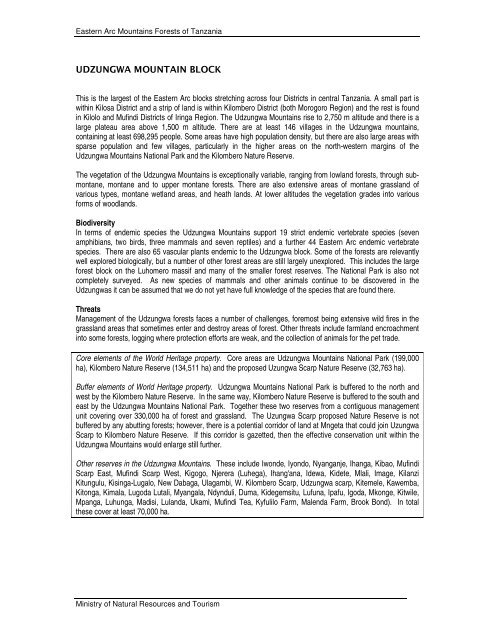eastern arc mountains forests of tanzania - Campaign for the ...
eastern arc mountains forests of tanzania - Campaign for the ...
eastern arc mountains forests of tanzania - Campaign for the ...
You also want an ePaper? Increase the reach of your titles
YUMPU automatically turns print PDFs into web optimized ePapers that Google loves.
Eastern Arc Mountains Forests <strong>of</strong> Tanzania<br />
UDZUNGWA MOUNTAIN BLOCK<br />
This is <strong>the</strong> largest <strong>of</strong> <strong>the</strong> Eastern Arc blocks stretching across four Districts in central Tanzania. A small part is<br />
within Kilosa District and a strip <strong>of</strong> land is within Kilombero District (both Morogoro Region) and <strong>the</strong> rest is found<br />
in Kilolo and Mufindi Districts <strong>of</strong> Iringa Region. The Udzungwa Mountains rise to 2,750 m altitude and <strong>the</strong>re is a<br />
large plateau area above 1,500 m altitude. There are at least 146 villages in <strong>the</strong> Udzungwa <strong>mountains</strong>,<br />
containing at least 698,295 people. Some areas have high population density, but <strong>the</strong>re are also large areas with<br />
sparse population and few villages, particularly in <strong>the</strong> higher areas on <strong>the</strong> north-western margins <strong>of</strong> <strong>the</strong><br />
Udzungwa Mountains National Park and <strong>the</strong> Kilombero Nature Reserve.<br />
The vegetation <strong>of</strong> <strong>the</strong> Udzungwa Mountains is exceptionally variable, ranging from lowland <strong><strong>for</strong>ests</strong>, through submontane,<br />
montane and to upper montane <strong><strong>for</strong>ests</strong>. There are also extensive areas <strong>of</strong> montane grassland <strong>of</strong><br />
various types, montane wetland areas, and heath lands. At lower altitudes <strong>the</strong> vegetation grades into various<br />
<strong>for</strong>ms <strong>of</strong> woodlands.<br />
Biodiversity<br />
In terms <strong>of</strong> endemic species <strong>the</strong> Udzungwa Mountains support 19 strict endemic vertebrate species (seven<br />
amphibians, two birds, three mammals and seven reptiles) and a fur<strong>the</strong>r 44 Eastern Arc endemic vertebrate<br />
species. There are also 65 vascular plants endemic to <strong>the</strong> Udzungwa block. Some <strong>of</strong> <strong>the</strong> <strong><strong>for</strong>ests</strong> are relevantly<br />
well explored biologically, but a number <strong>of</strong> o<strong>the</strong>r <strong>for</strong>est areas are still largely unexplored. This includes <strong>the</strong> large<br />
<strong>for</strong>est block on <strong>the</strong> Luhomero massif and many <strong>of</strong> <strong>the</strong> smaller <strong>for</strong>est reserves. The National Park is also not<br />
completely surveyed. As new species <strong>of</strong> mammals and o<strong>the</strong>r animals continue to be discovered in <strong>the</strong><br />
Udzungwas it can be assumed that we do not yet have full knowledge <strong>of</strong> <strong>the</strong> species that are found <strong>the</strong>re.<br />
Threats<br />
Management <strong>of</strong> <strong>the</strong> Udzungwa <strong><strong>for</strong>ests</strong> faces a number <strong>of</strong> challenges, <strong>for</strong>emost being extensive wild fires in <strong>the</strong><br />
grassland areas that sometimes enter and destroy areas <strong>of</strong> <strong>for</strong>est. O<strong>the</strong>r threats include farmland encroachment<br />
into some <strong><strong>for</strong>ests</strong>, logging where protection ef<strong>for</strong>ts are weak, and <strong>the</strong> collection <strong>of</strong> animals <strong>for</strong> <strong>the</strong> pet trade.<br />
Core elements <strong>of</strong> <strong>the</strong> World Heritage property. Core areas are Udzungwa Mountains National Park (199,000<br />
ha), Kilombero Nature Reserve (134,511 ha) and <strong>the</strong> proposed Uzungwa Scarp Nature Reserve (32,763 ha).<br />
Buffer elements <strong>of</strong> World Heritage property. Udzungwa Mountains National Park is buffered to <strong>the</strong> north and<br />
west by <strong>the</strong> Kilombero Nature Reserve. In <strong>the</strong> same way, Kilombero Nature Reserve is buffered to <strong>the</strong> south and<br />
east by <strong>the</strong> Udzungwa Mountains National Park. Toge<strong>the</strong>r <strong>the</strong>se two reserves from a contiguous management<br />
unit covering over 330,000 ha <strong>of</strong> <strong>for</strong>est and grassland. The Uzungwa Scarp proposed Nature Reserve is not<br />
buffered by any abutting <strong><strong>for</strong>ests</strong>; however, <strong>the</strong>re is a potential corridor <strong>of</strong> land at Mngeta that could join Uzungwa<br />
Scarp to Kilombero Nature Reserve. If this corridor is gazetted, <strong>the</strong>n <strong>the</strong> effective conservation unit within <strong>the</strong><br />
Udzungwa Mountains would enlarge still fur<strong>the</strong>r.<br />
O<strong>the</strong>r reserves in <strong>the</strong> Udzungwa Mountains. These include Iwonde, Iyondo, Nyanganje, Ihanga, Kibao, Mufindi<br />
Scarp East, Mufindi Scarp West, Kigogo, Njerera (Luhega), Ihang'ana, Idewa, Kidete, Mlali, Image, Kilanzi<br />
Kitungulu, Kisinga-Lugalo, New Dabaga, Ulagambi, W. Kilombero Scarp, Udzungwa scarp, Kitemele, Kawemba,<br />
Kitonga, Kimala, Lugoda Lutali, Myangala, Ndynduli, Duma, Kidegemsitu, Lufuna, Ipafu, Igoda, Mkonge, Kitwile,<br />
Mpanga, Luhunga, Madisi, Lulanda, Ukami, Mufindi Tea, Kyfulilo Farm, Malenda Farm, Brook Bond). In total<br />
<strong>the</strong>se cover at least 70,000 ha.<br />
Ministry <strong>of</strong> Natural Resources and Tourism


